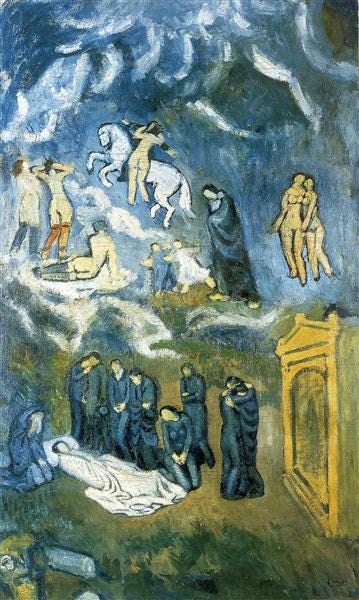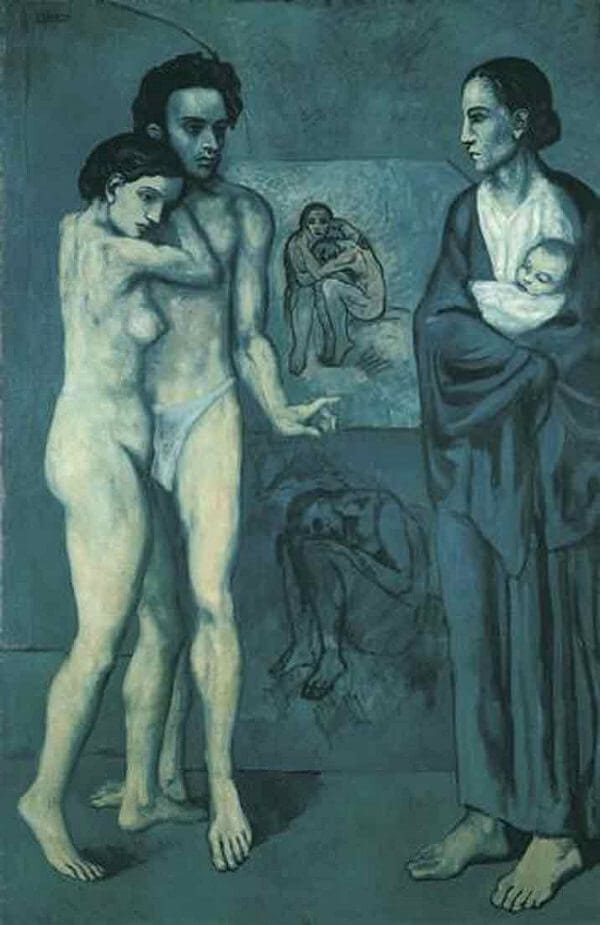Picasso and Casagemas: Els Quatre Gats and Picasso’s Blue Period
A study of Picasso's brief but influential relationship with Carles Casagemas
This study explores Picasso’s friendship with Carles Casagemas starting in 1889 through their shared connection with Els Quatre Gats café in Barcelona up until Casagemas’s suicide in February 1901, an event that significantly influenced Picasso’s Blue period (1901-1904).
Pablo Ruiz Picasso (1881-1973) came to Barcelona in 1895 where his father Ruiz had taken up a teaching post at La Llojta art school. Picasso’s precocious impact on the Barcelona art scene in the period 1900 to 1904 revolved around his involvement with Els Quatre Gats where he had solo exhibitions in February and July 1900. In June 1897, Ramon Casas (1866-1932), Santiago Rusiño (1861-1931), Miquel Utrillo (1862-1934) and the entrepreneur Pere Romeu (1862-1908) opened Els Quatre Gats café on carrer Montsió. Rusiñol and Casas, influential Catalan painters and leading representatives of the Modernisme movement in Catalonia that flourished in the 1880s and 1890s (Mendoza, “Casas and Rosinal” 52), befriended Utrillo, Paris correspondent for the Catalan newspaper La Vanguardia, while in Paris between 1889 and 1992 (46). The name Els Quatre Gats reflected the four founding ‘cats’, but also paid homage to the Chat Noir, a bohemian café and cabaret in Montmartre owned by the impresario Rodolphe Salis (1851-1897) (Mendoza, “Quatre Gats” 80-81). Until its closure in 1903, Els Quatre Gats became the centre for Modernisme in Barcelona (Lord 39-40). As well as an exhibition space, Es Quatre Gats was an avant-garde forum for music, literary evenings, puppet shows and shadow plays (Doñate).
Picasso’s exhibition at Els Quatre Gats in February 1900 had been influenced by Casas’s exhibition in October 1899 at the gallery Sala Parés of a series of portraits, including 132 charcoal drawings highlighted with pastel, of well-known personalities in his circle (Mendoza, “Quatre Gats” 84-85; McCully 176-78). Picasso displayed between 50 and 150 charcoal portraits of his friends, modelled on the drawings of Casas (Mendoza, “Quatre Gats” 86). Picasso also exhibited the painting Last Moments (Les Derniers Moments), selected on 24 February 1900 for the Exposition Universelle in Paris that year (Mallen 3).[1] In July 1900, Picasso again exhibited at Els Quatre Gats, showing four pastels of bull-fighting, praised by the art critic Pujolà i Vallès in Las Noticias on 23 July (Mendoza, “Casas and Picasso” 28). At this time, Picasso became a close friend of Ramon Pichot (1871-1925), who had exhibited at Els Quatre Gats in February 1899, briefly sharing a studio in Barcelona and later a room and exhibiting together in Paris in 1902 (Falgàs 96-97).
Carles Casagemas (1881-1901)[2] was an exhibitor, publisher, and puppet show performer at Els Quatre Gats from its opening in June 1897 (Bru i Turull). From 26 March to 10 April 1990, Casagemas exhibited drawings at Els Quatre Gats in a style employing strong outlines, influenced by Picasso and Isidre Nonell (1892-1911), a Catalan painter who also moved between Barcelona and Paris between 1897 and 1900 (Falgas 102; Fontbana 102). “The customary Modernist themes, redolent with ugliness, sorrow, and desolation, were handled in a highly original style by Casagemas. According to one critic, the artist’s romantic vision of a garden, in one instance, was ample proof that he was not insensitive to beauty” (Doňate 232).
Casagemas and Picasso had met in Spring 1899 (Falgàs 99). From January to September 1900, they shared a loft studio in Barcelona (Robinson 63). From September to December 1990, together with Manuel Pallarès, they rented the former studio of Nonell in Paris and in this period Casagemas met the model Germaine Gargallo (1880-1948) (Ocaňa 152-53). Following a fractious stay with Picasso in Malaga from December to January 1901 (Ocaňa 157), Casagemas returned to Paris in February to see Germaine (Robinson 64), while Picasso went to Madrid to work on illustrations for Arte Joven, a periodical started by his friend Francisco de Asís Soler (Mendoza, “Casas and Picasso” 28-30; Gual 108-09). On the evening of 17 February, Casagemas hosted a dinner at the Café Hippodrome in Pigalle. At the end of the dinner, Casagemas fired a shot at Germaine which grazed her but, believing he had killed her, Casagemas shot himself and died the same night (Robinson 64; Chalif 404).
On his return to Paris in May 1901, Picasso resided in the apartment he had shared with Casagemas and embarked on a brief affair with Germaine (Robinson 80). On his return to Barcelona in 1902, Picasso painted Portrait de Germaine, “one of the most touching and tender of all the blue period works” (Chalif 414). On 24 June 1901, an exhibition of Picasso’s work opened at the gallery of Ambroise Vollard (1866-1939) to acclaim from the art critic Félicien Fagus in La Revue Blanche (Ocaňa 135).[3] But Picasso’s thematic interest in the Parisian demi-monde represented in the Vollard exhibition had faded by late 1901 (McCully, “Picasso’s Artistic Practice” 54) to be replaced by pre-occupation with Casagemas’ suicide (Rafart i Planas 188-89; Parkinson 62-63) and the tonalities of his Blue period (McCully 52-56).
In 1901 Picasso painted a number of studies of Casagemas, including the Van Gogh inspired The Death of Casagemas and “the intuitive ingenious painting” Portrait of the Dead Casagemas (188). In the same year, Picasso “even went so far as to superimpose the dead Casagemas profile … onto that of his poet-friend Sabarte’s in the painting Le Bock” (McCully 180).
The Death of Casagemas (1901)
The Burial of Casagemas (or Evocation) (1901), Picasso’s pictorial testament to Casagemas, coincided with the beginning of his Blue Period (180).[4]
The Burial of Casagemas (1901)
La Vie (1903) is the most remarkable achievement of this period in terms of its symbolic power and compositional richness, in which Picasso replaced himself by Casagemas as the principal figure in the composition (Robinson 5).
La Vie (1903)
While La Vie marked the end of Picasso’s intensive pictorial engagement with Casagemas’ suicide (Rafart i Planas 189), the news of the death on 1 March 1925 of Pichot, who had married Germaine in 1906, led Picasso to modify his masterpiece The Three Dancers (1925): “It became a paradigm of the relationship between man and woman, a sort of Dance of Life that is also a Dance of Death, with Ramon Pichot on the right, Germaine on the left and Casagemas as it were crucified between them”(Alley 598).
The Three Dancers (1925)
WORKS CITED
Alley, Ronald. Catalogue of the Tate Gallery's Collection of Modern Art other than Works by British Artists, Tate Gallery and Sotheby Parke-Bernet, 1981, pp. 598-605.
Bru I Turull, Ricard. “Exhibition Review of “Casagemas: The Artist beneath the Myth,” Nineteenth-Century Art Worldwide, vol. 14, no. 1, 2015. www.19thc-artworldwide.org/index.php/spring15/bru-reviews-casagemas-the-artist-beneath-the-myth (accessed 22 December 2020).
Chalif, David J. “The Death of Casagemas: Early Picasso, the Blue Period, Mortality, and Redemption.” Neurosurgery, vol. 61, 2006, pp. 404-17. doi: 10.1227/01.NEU.0000255482.80697.80.
Doñate, Mercè. “Art Activity at Els Quatre Gats.” Ocaňa, Picasso and Els 4 Gats, pp. 223-36.
Falgàs, Jordi. “Picasso’s Fellows at the Tavern: Beyond Modernisme?” Robinson et al., pp. 96-103.
Fontbaba, Francesc. “The Second Generation of Modernista Painters.” Robinson et al., pp. 54-60.
Gual, Malén. “Modernist Picasso.” Robinson et al, pp. 103-11.
Lord, Carmen Belen. “The New Art: Modernisme.” Robinson et al., pp. 34-41.
Mallen, Enrique. “Reaching for Success: Picasso’s Rise in the Market (The First Two Decades).” The Artist and Journal of Home Culture, vol. 6, 2017, pp. 1-21.
McCully, Marilyn. “Picasso’s Artistic Practice in 1901.” Becoming Picasso: Paris 1901, The Courtauld Gallery/Paul Holberton Publishing, 2013, pp. 137-59.
---. “Picasso’s Portraits of his Barcelona Friends.” Ocaňa, Picasso and Els 4 Gats, pp. 175-86.
Mendoza, Cristina. “Casas and Rusiñol: The Allure of Montmartre.” Robinson et al., pp. 42-53.
---. “Casas and Picasso.” Ocaňa, Picasso and Els 4 Gats, pp. 21-32.
---. “Quatre Gats and the Origins of Picasso’s Career.” Robinson et al., pp. 80-91.
Ocaňa, Maria Teresa. “Chronicle from Paris.” Ocaňa, Picasso and Els 4 Gats, pp. 151-62.
---. “Picasso’s Blue Period.” Robinson et al., pp.135-41.
Parkinson, Gvin. “Incipit Picasso: From The Birth of Tragedy to The Burial of Casagemas.” Becoming Picasso: Paris 1901, The Courtauld Gallery/Paul Holberton Publishing, 2013, pp. 61-83.
---, editor. Picasso and Els 4 Gats: The Early Years in Turn-of-the-Century Barcelona. Bulfinch Press, 1996.
Rafart i Planas, Claustre, “Els Quatre Gats seen through the Metamorphosis of the Blue Period.” Ocaňa, Picasso and Els 4 Gats, pp. 187-205.
Robinson, William H. Picasso and the Mysteries of Life: La Vie. Cleveland Museum of Art, 2012.
Robinson, William H. et al., editors. Barcelona and Modernity: Picasso, Gaudí, Miró, Dalí. Cleveland Museum of Art/Yale UP, 2006
[1] The painting subsequently disappeared but was revealed by X-radiography analysis carried out by the Cleveland Museum of Art in 1978 to have been painted over by Picasso for his blue period work La Vie (1903)(Robinson 29).
[2] The first exhibition exclusively devoted to the work of Casagemas was held at the National Art Museum of Catalonia from 31 October 2014 to 22 February 2015. The catalogue of the exhibition, The Artist beneath the Myth (2014), is edited by Eduard Vallè with essays by Francesc Fontbana, Artur Ramon and Dolors Rodriguez.
[3] For a list of works exhibited by Picasso at the Vollard Exhibition, see: Marilyn McCully and Michael Raeburn, “Appendix: Works in the 1901 Vollard show.” Becoming Picasso: Paris 1901, The Courtauld Gallery/Paul Holberton Publishing, 2013, pp. 177-81.
[4] See for influences on Picasso’s The Death of Casagemas and The Burial of Casagemas: Cowling, Elizabeth. Pablo Picasso: Style and Meaning. Phaidon, 2002, pp. 85-87.







